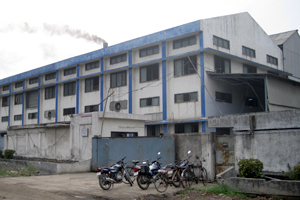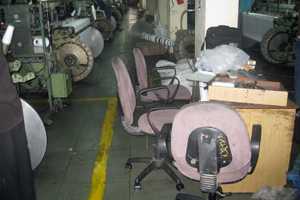Management issues
An economist studies how outdated practices diminish results at Indian firms.
By Brooke E. OíNeill, AMí04
Photography courtesy Nicholas Bloom

Inefficient management at Indian companies increases risk and diminishes revenues.
The first time Stanford economist Nicholas Bloom visited an Indian textile company, he felt as if he’d traveled back in time to a 19th-century factory. Oil stains splattered the floor. Flammable garbage lurked in corners. Vats of toxic chemicals sat uncovered in open areas, and inventory rooms were piled high with unlabeled, unprotected bags of yarn. Massive looms whirled inches from workers. “If your shirt happened to get caught,” he says, “you’d just be sucked in and killed instantly.”
Management practices were even more outdated than the safety standards. “These factories are from a generation before,” says Bloom, showing photographs of the disarray at a late February conference sponsored by the University’s Milton Friedman Institute for Research in Economics. Titled “Measuring and Analyzing Economic Development,” the daylong event drew roughly 130 economists and students to pinpoint the most effective methodologies for doing economic research in the developing world. In Bloom’s case, he went inside India’s largest industry—textiles—to test how basic management tools could improve productivity.

Danger lurks in a textile plantís disarray.
Indian firms, excluding multinational subsidiaries, have long scored lower on productivity than companies in many other countries. Bloom and his research team spent the past two years running a field experiment, funded in part by the World Bank, at 20 large textile plants near Mumbai. Typically family-run and in operation for at least two decades, the sample factories had yet to adopt business strategies standard in the United States, Europe, and Japan. Because of informational barriers, Indian managers were unfamiliar with management technologies used in the developed world. “It’s the land that ‘Lean’ forgot,” says Bloom, referring to a common manufacturing philosophy based largely on Toyota’s longstanding production system that emphasizes efficient processes. Many companies, for example, had never heard of clear employee performance goals and quality-control measures. To see whether these omissions were hampering productivity, Bloom split the factories into two groups: One received free, ongoing consulting from Accenture, which introduced “basic management practices.” The other did not.
Most of the 38 improvement measures initiated by the consultants, says Bloom, were relatively low-tech, quality-control procedures. Before the intervention, for example, about 20 percent of factory manpower went to repairs. The repairmen’s work, he says, could generally be boiled down to two modes: “reading newspapers and waiting for something to break down, or running around frantically when things broke down.” Accenture introduced a simple fix: instead of waiting for disaster to strike, the repairmen tagged old or damaged machine parts and performed preventative maintenance on the most dilapidated looms. Managers, in turn, kept detailed logs of breakdowns and held weekly meetings to analyze quality data. Keeping more detailed inventory records also helped, allowing managers and designers to use excess yarn colors in future patterns.
The changes, says Bloom, “made a huge difference.” Within five months, productivity increased by roughly 15 percent, on average, among the experimental group, and profitability improved by an estimated $500,000, or 24 percent, annually. But consulting isn’t a quick fix, cautions Bloom. Two years after the project began, Accenture has scaled down its team but continues to measure longer-term outcomes, give occasional suggestions, and make sure companies keep up the practices. “You want to hang in there with these firms,” says Bloom, who compares the ongoing consulting advice to a periodic check-up after five months of daily lessons.
Despite the results, implementation problems—such as companies relapsing into old habits when the consultants leave—have sometimes made Bloom’s research a tough sell with fellow economists. Traditionally, he says, the field has been skeptical about whether management affects productivity. Many see it as a “nebulous concept,” difficult to measure and quantify.
Bloom has developed a survey methodology that turns qualitative interview responses from thousands of companies—about goals, promotion systems, and other quality gauges—into a quantitative score of management ability. Then there’s the “traditional Chicago view,” he says, “that bad management will be ruthlessly driven out of the market.” Yet in a country like India, where cheap labor allows even poorly run companies to turn a profit, the free market doesn’t run so free. As Bloom’s research attests, companies with subpar management can survive. But with some small changes, they can do much better.
